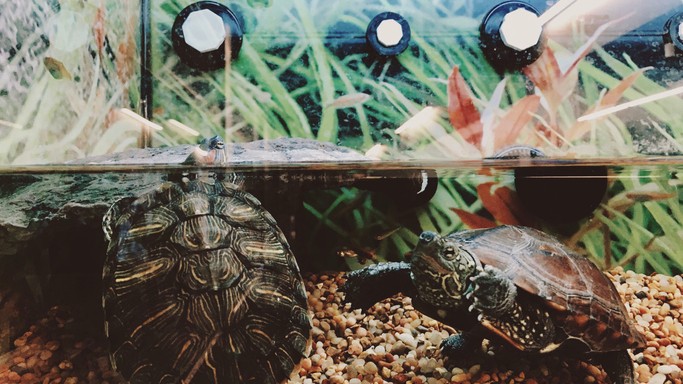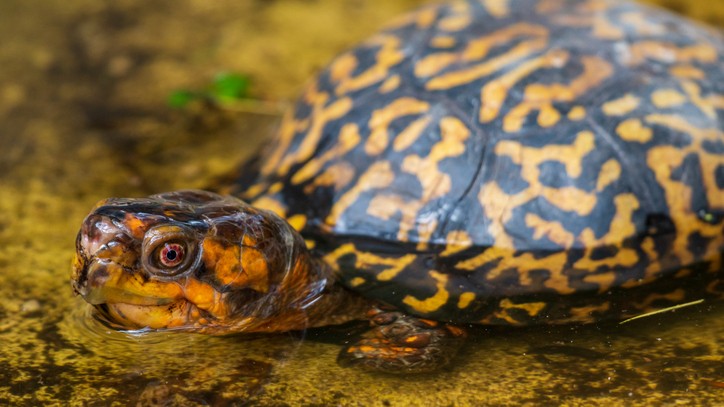What do pet turtles eat? Five things to know before you bring home a turtle
Before you bring home a pet turtle, it’s important to familiarize yourself with basic turtle care and health

“What do pet turtles eat, anyway?" If you’re considering the purchase of a pet turtle, you may have already found yourself asking this question. While that’s one important thing to learn before bringing home a new pet turtle, there are many other aspects of turtle care that also need to be taken into consideration. There’s far more to turtle care than simply buying one of the best turtle tanks and some turtle food! Here are five turtle questions that you should ask yourself, and answer, before you consider bringing home a pet turtle.
1. What do pet turtles eat?
While the majority of turtles are omnivores, eating both plants and animals, some turtle species are fully herbivores (plant-eaters) or fully carnivores (meat-eaters). Box turtles are omnivores, but tend to be more carnivorous than many pet owners expect. In the wild, they typically eat beetles, insect larvae, cockroaches, flies, grasshoppers, fish, frogs, and other animals, in addition to mushrooms, berries, flowers, and grasses. Aquatic turtles, such as red-eared sliders, are also typically omnivorous, with a diet consisting of fish, frogs, and aquatic plants.
A commercial turtle diet can be a good starting point for meeting your turtle’s nutritional requirements. When you purchase turtle food, be sure to purchase a food that is intended for your specific turtle. Different turtle species have different nutritional requirements, so it’s important to feed aquatic turtles an aquatic turtle diet and to feed box turtles a box turtle diet.
In addition to a commercial diet, your turtle should also eat fresh food. Box turtles should be fed fresh vegetables, such as carrots, bell peppers, kale, and broccoli. Box turtles also benefit from animal proteins, such as mealworms, crickets, and earthworms. Aquatic turtles should also be fed fresh foods, such as leafy green vegetables, insects, krill, and minnows. Iceberg lettuce should be avoided in both box turtles and aquatic turtles, because it lacks many of the nutrients that can be found in other vegetables.
2. Where should my pet turtle live?
Just like food, a turtle’s optimal living arrangements depend upon the type of turtle.
The ideal housing for a box turtle is a large, outdoor enclosure, which mimics your turtle’s natural environment. The walls of this enclosure should be at least 18 inches high, in order to keep your turtle from climbing out. This enclosure should include both sunny and shaded areas, so that your turtle can regulate its body temperature by seeking sun or shade. If an outdoor enclosure isn’t an option, an indoor enclosure can be used. An aquarium isn’t large enough for a box turtle; instead, you should use a kids’ swimming pool or other large, open tank. The bottom of indoor enclosures should be filled with soil or mulch, which must be cleaned regularly.
Aquatic turtles can be housed in an outdoor pond or a large indoor aquarium. Regardless of whether they are housed indoors or outdoors, aquatic turtles need an enclosure that is large enough to allow room for both swimming and diving. They need a dry area within their enclosure, so that they can climb out of the water when desired. When aquatic turtles are housed in an outdoor pond, it’s important to ensure that there are both shaded and sunny areas available.

3. What are the lighting and temperature requirements for indoor pet turtles?
If your box turtle is housed indoors, you need to maintain the temperature of its enclosure at 70-90°F (21-32°C). Additionally, your turtle needs access to a warm basking area, that is heated by a heat lamp to a temperature of 85-90°F (29-32°C). In addition to a heat lamp, your turtle needs a UV lamp that provides at least 5% UVA/UVB lighting. These UV bulbs must be changed every six months; they will stop emitting UV light long before the light bulb visibly “burns out.”
The water temperature for aquatic turtles should be maintained at 75-82°F (24-28°C). Like box turtles, aquatic turtles also require a warm basking area. However, the temperature requirement for an aquatic turtle basking environment is even higher than that for a box turtle; an aquatic turtle basking area should be maintained at a temperature of 90-95°F (32-35°C). In addition to a heat lamp, aquatic turtles also must have a UV light located over their basking area.
4. How long will my pet turtle live?
While aquatic turtles typically live 20-30 years, it’s not uncommon for box turtles to live 30-60 years! A pet turtle represents a life-long commitment. Many people purchase turtles as gifts for children, thinking they will be an easy and low-maintenance pet for their kids to gain a sense of responsibility and learn about pet care. Unfortunately, this couldn’t be further from the truth! When cared for correctly, turtles require work, effort, and a significant long-term commitment.
5. Does my pet turtle need veterinary care?
Absolutely! Like any other pet, turtles require regular veterinary care. You will need to find a veterinarian that is comfortable with turtles and other exotic pets, in order to provide high-quality preventative care for your turtle. This preventative care should include a physical exam every 6-12 months, fecal parasite testing at least once yearly, and additional lab tests (such as bloodwork) if your turtle is ill.
Common medical conditions in pet turtles include pneumonia, ear abscesses, parasites, skin infections, Vitamin A deficiency, and metabolic bone disease. Your veterinarian can help you prevent these conditions, in addition to helping you treat any medical issues that may arise.
Turtles are not as low-maintenance as they appear!
While caring for a turtle certainly isn’t impossible, caring for these pets can be more complex than you might think at first glance. Turtles were once viewed as an easy and appropriate pet for young kids, but we are increasingly beginning to realize that is not always the case. In addition to the Salmonella risks that small turtles can pose for young children, the proper care of a pet turtle requires far more than a tiny little countertop turtle pond. In order to provide the best possible care for turtles, it’s best to look beyond the obvious questions, going from “what do pet turtles eat?” to “how can I create the optimal environment to support my pet turtle’s health?”
PetsRadar Newsletter
Get the best advice, tips and top tech for your beloved Pets
Dr. Barnette is a graduate of the University of Florida, where she received both her B.S. in Zoology and her Doctor of Veterinary Medicine (DVM). She has 15 years of clinical experience as a small animal veterinarian, treating dogs, cats, and occasional exotic patients. She now works as a freelance veterinary writer, creating educational content for veterinarians, veterinary team members, and dedicated pet owners. Dr. Barnette lives in southwest Florida with her husband and daughter (plus two cats, a dog, and a rescued dove!) and enjoys kayaking, biking, and hiking. Learn more about Dr. Barnette at www.linkedin.com/in/catherinebarnette.

